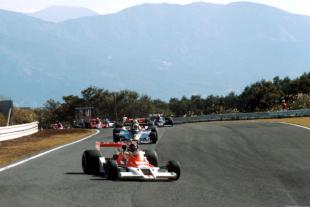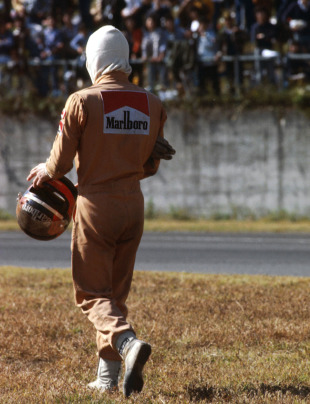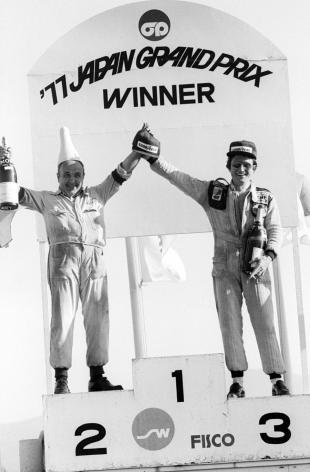- Rewind to ... the 1977 Japanese Grand Prix
Fuji's failed finale

- Race:
- Japanese Grand Prix
- Championship:
- FIA Formula One World Championship
- Drivers:
- Patrick Depailler
- |
- James Hunt
- |
- Ronnie Peterson
- |
- Carlos Reutemann
- |
- Gilles Villeneuve
After such a dramatic debut in 1976, the Japanese Grand Prix was run in rather different circumstances the following year. James Hunt had snatched the title from Niki Lauda 12 months previously, but by the time Formula One returned to Mount Fuji Lauda was already champion and had refused to drive for Ferrari.
Lauda had wrapped up the title at Watkins Glen with two rounds remaining, and with the Canadian and Japanese races left his Ferrari team decided to run a third car to give the emerging Gilles Villeneuve race experience ahead of his first full season in 1978. Lauda, however, felt that Ferrari would not be able to run three cars competitively, and so quit the team two races early ahead of his move to Brabham.
The more recent races had seen a close fight develop between Hunt and Mario Andretti. Hunt had won from Andretti at Watkins Glen, and was then leading as the pair dominated in Canada when a collision with his team-mate Jochen Mass - who was being lapped - forced Hunt to retire. In his anger, he punched a marshal to the floor as the end of the season threatened to turn sour. Worse was to come in Fuji, however, and it was Villeneuve who would be at the centre of tragedy.
In a far cry from 1976, interest in the race was severely depleted. With not a lot to race for, Fittipaldi, Penske and Renault decided not to travel at all, while visa problems for Ian Scheckter meant March ran only one car rather than bring in a replacement. The field was boosted slightly by the entry of two Kajima cars for their home race, along with a Muritsu Tyrrell for Kunumitsu Takahashi.
Again it was Hunt and Andretti who resumed battle in qualifying, with Andretti getting the edge over Hunt by less than 0.2 seconds. A close third was John Watson, who lined up alongside his team-mate Hans-Joachim Stuck. Jacques Lafitte was fifth in his Ligier, ahead of Jody Scheckter's Wolf. Despite Carlos Reutemann qualifying seventh in the Ferrari, Villeneuve could only set a time good enough for 20th place.

Andretti bogged down terribly at the start and dropped to eighth place, allowing Hunt to lead away from the fast-starting Scheckter and team-mate Jochen Mass who had surged through to third from eighth on the grid. Andretti started trying to recover but having dispatched Stuck he made contact with Lafitte and was out on the second lap.
It was on lap six though that tragedy struck. Further down the field, Villeneuve was catching Ronnie Peterson in the Tyrrell as he tried to further impress Ferrari. Heading in to turn one, at the end of the long main straight, Villeneuve outbraked himself and ran in to the back of Peterson at high speed. The Ferrari was launched off the back of the Tyrrell and cartwheeled through the catch fencing and over the barrier.
Miraculously, Villeneuve walked away from the horrifying crash unharmed, but two other men weren't so lucky. Having cut to the wreckage, television pictures showed the gruesome sight of a marshal and a photographer who had been hit by the Ferrari. Both were killed, and several spectators injured. They had been standing in a restricted area, but the death toll could have been much higher as the marshal was actually clearing spectators from the area at the time of the accident.
As was the norm, the race was not stopped, with Motorsport magazine's description of the incident an example of how used to death the Formula One paddock had become:
"Going into his sixth lap, Villeneuve inadvertently left his braking too late at the end of the start/finish straight and ran his Ferrari into the back of Peterson's Tyrrell. The Italian car climbed up over the six wheeler, knocking off its rear wing in the process, before launching Villeneuve into a heart-stopping series of end-over-end somersaults. The Ferrari was totally destroyed during its crazy flight which unfortunately ended over the top of a track side guard rail and in amongst some onlookers in a prohibited area. Villeneuve is a little champ and, by virtue of tucking himself deep down into the cockpit, luckily escaped without injury. Unfortunately a local marshal and a photographer were killed. Peterson, also, was out of the race as a result of the collision."

The race continued, and, without Andretti to challenge him, Hunt was dominant over the rest of the field, which was left to battle for second place. Scheckter was overtaken by Mass and Watson before both retired, and then Clay Regazonni took second before his engine gave up.
Reutemann and Laffite both had turns running second until Laffite ran out of fuel on the penultimate lap, eventually being classified fifth. That allowed Reutemann to take second behind Hunt, with Patrick Depailler third having started 15th.
After the day's events the podium ceremony was going to be no place for celebration, and in a sign of the mood both Hunt and Reutemann skipped the podium in search of a quick exit from the circuit, leaving Depailler on his own.
Following two notable races for completely contrasting reasons, the Japanese Grand Prix did not return to Fuji in 1978. After the deaths the race was absent from the calendar for a decade until it returned at a new venue - Suzuka - in 1987. It would be thirty years until Fuji hosted a grand prix again.
Chris Medland is the assistant editor on ESPNF1

